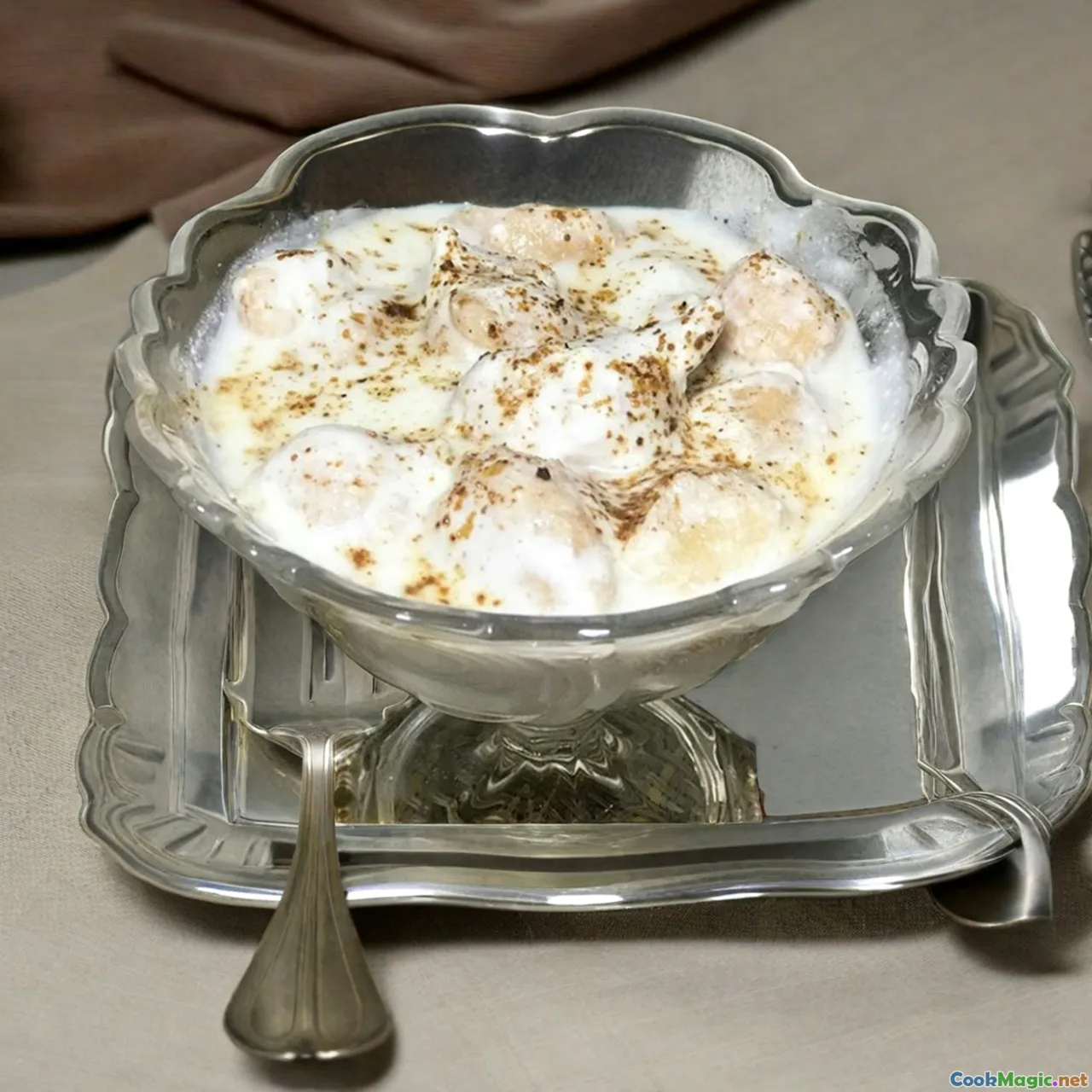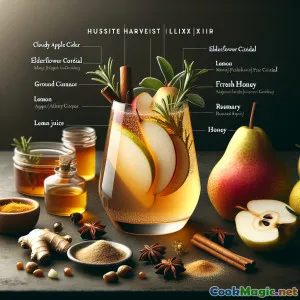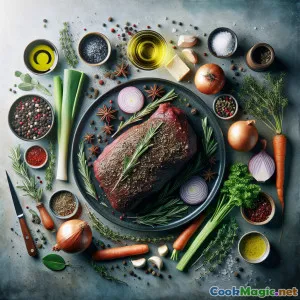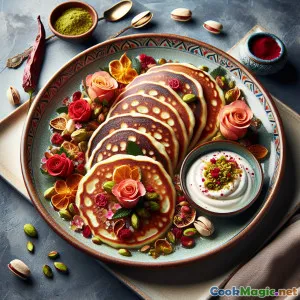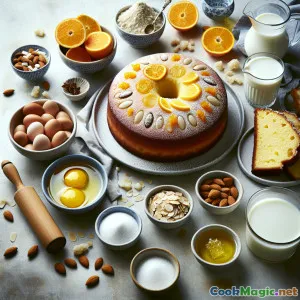
シラカバ樹液&大麦のクリームポット:イングランドの喜び
(Birch Sap & Barley Cream Pots: An English Delight)
(0 レビュー)材料
-
60 grams パール麦
(冷水で洗い流す)
-
300 ml 全乳
(大麦の調理)
-
200 ml シラカバの樹液
(新鮮または瓶詰め; よりマイルドな味のココナッツウォーターに置き換え可能)
-
250 ml ダブルクリーム
(リッチさと滑らかな食感のために)
-
60 grams キャスターシュガー
(シナモンの甘さに応じて好みに調整してください)
-
3 large 卵の黄身
(室温)
-
1 whole バニラビーンズ
(分割して種をこそげ取るか、バニラペーストを小さじ1使用します)
-
1/4 tsp 海塩
(風味を高める)
-
2 tsp 蜂蜜
(イギリスの野生花、かける用に)
-
20 grams ローストヘーゼルナッツ
(ざく切り、飾り用)
(冷水で洗い流す)
(大麦の調理)
(新鮮または瓶詰め; よりマイルドな味のココナッツウォーターに置き換え可能)
(リッチさと滑らかな食感のために)
(シナモンの甘さに応じて好みに調整してください)
(室温)
(分割して種をこそげ取るか、バニラペーストを小さじ1使用します)
(風味を高める)
(イギリスの野生花、かける用に)
(ざく切り、飾り用)
栄養
- 分量: 4
- 1人分の量: 1 ラメキン(150ml)
- Calories: 350 kcal
- Carbohydrates: 33 g
- Protein: 7 g
- Fat: 21 g
- Fiber: 2.5 g
- Sugar: 13 g
- Sodium: 70 mg
- Cholesterol: 134 mg
- Calcium: 115 mg
- Iron: 1.2 mg
作り方
-
1 - ミルクで大麦を煮る:
ペール麦を洗い、小さな鍋に全乳とともに加えます。弱火で静かに煮込み、蓋をせずに麦が非常に柔らかくなるまで約25分間調理します。焦げ付かないように頻繁にかき混ぜてください。火からおろし、少し冷ましておきます。
-
2 - クリーミーさのためにブレンド:
調理した大麦と残った牛乳をブレンダーに入れます。できるだけ滑らかになるまでよくブレンドしてください。残っている大麦の殻を取り除くために細かい目のふるいを通してください。より滑らかな食感に仕上がります。
-
3 - シラカバの樹液とクリームを抽出:
清潔なソースパンに、白樺樹液、ダブルクリーム、濾した大麦の混合物、バニラのさやの種(使用する場合)を入れます。やさしく火にかけ、絶えずかき混ぜながら、蒸気が出始める程度まで温めますが、沸騰させないようにします。
-
4 - 卵黄と砂糖を準備する:
その間、大きなボウルで卵黄を粉砂糖と海塩とともに泡立て、色が薄くなり少しとろみが出るまで混ぜる。
-
5 - 下味をつけて混ぜる:
熱いカバの木麦芽クリームの約3分の1を絶えず泡立てながら卵の混合物にゆっくりと注ぎます。温度が整ったら、残りの熱い液体とともに卵の混合物を鍋に戻し泡立てます。
-
6 - カスタードベースを調理:
弱火で、カスタードの混合物を絶えず泡立てながら、とろみがつきスパチュラにコーティングできるくらいになるまで(温度計を使う場合は約82°C)加熱します。沸騰させないでください。
-
7 - ラメキンで冷やす:
4つの150mlのラメキンに分けてください。室温まで冷ましてから、蓋をして冷蔵庫で少なくとも2時間冷やし、柔らかく固まるまで待ちます。
-
8 - 飾り付けと盛り付け:
盛り付ける際に、上に少量のイギリス産蜂蜜を垂らし、刻んだトーストしたヘーゼルナッツを散らします。冷たくクリーミーにお召し上がりください。
ペール麦を洗い、小さな鍋に全乳とともに加えます。弱火で静かに煮込み、蓋をせずに麦が非常に柔らかくなるまで約25分間調理します。焦げ付かないように頻繁にかき混ぜてください。火からおろし、少し冷ましておきます。
調理した大麦と残った牛乳をブレンダーに入れます。できるだけ滑らかになるまでよくブレンドしてください。残っている大麦の殻を取り除くために細かい目のふるいを通してください。より滑らかな食感に仕上がります。
清潔なソースパンに、白樺樹液、ダブルクリーム、濾した大麦の混合物、バニラのさやの種(使用する場合)を入れます。やさしく火にかけ、絶えずかき混ぜながら、蒸気が出始める程度まで温めますが、沸騰させないようにします。
その間、大きなボウルで卵黄を粉砂糖と海塩とともに泡立て、色が薄くなり少しとろみが出るまで混ぜる。
熱いカバの木麦芽クリームの約3分の1を絶えず泡立てながら卵の混合物にゆっくりと注ぎます。温度が整ったら、残りの熱い液体とともに卵の混合物を鍋に戻し泡立てます。
弱火で、カスタードの混合物を絶えず泡立てながら、とろみがつきスパチュラにコーティングできるくらいになるまで(温度計を使う場合は約82°C)加熱します。沸騰させないでください。
4つの150mlのラメキンに分けてください。室温まで冷ましてから、蓋をして冷蔵庫で少なくとも2時間冷やし、柔らかく固まるまで待ちます。
盛り付ける際に、上に少量のイギリス産蜂蜜を垂らし、刻んだトーストしたヘーゼルナッツを散らします。冷たくクリーミーにお召し上がりください。
シラカバ樹液&大麦のクリームポット:イングランドの喜び :の詳細
Birch Sap and Barley Cream Pots
Summary
This wholly original recipe for Birch Sap and Barley Cream Pots captures the gentle awakening of an English spring in a delicate, creamy dessert bowl. Combining the subtle, natural sweetness of birch sap with the nutty, old-world flavors of barley, and elevating it all with rich dairy and softly set custard, this dish blurs the lines between modern British innovation and age-old traditions. Its unassuming, creamy aesthetics hint at something more interesting upon first spoonful—an earthy complexity and layers of silky, gentle sweetness.
History and Cultural Significance
Birch sap, gathered from centuries-old woodland traditions, was once a celebrated ingredient in the Northern Hemisphere—tapped for just a few short weeks each spring. In the UK, though largely forgotten in mainstream cuisine, folklore remembers birch sap as a rejuvenating 'British tonic,' sometimes fermented into wine or mixed into healing concoctions. Barley’s role as a staple cereal can be traced from Neolithic times to roots in rustic British desserts and hearty stews, symbolizing resilience, comfort, and an affinity with the landscape.
Combining birch sap with barley in a creamy custard was inspired by traditional milk puddings and contemporary farmhouse desserts, but here given a new voice—bridging foraged, historic flavors and classic dessert typology.
Unique Aspects and Personal Notes
Birch Sap and Barley Cream Pots stand out not just for their writeup of “wild sophistication:”
-
The birch sap brings unique complexity, lightly floral, slightly sweet, unlike anything sugar or syrup could impart. Using birch sap as a base (where you might otherwise reach for milk, water, or coconut water) coaxes out woodsy, sappy nuances and gently perfumes the dessert.
-
Barley lends nutty undertones and provides a textural base for the custard when rendered ultra-smooth. It bulks the cream without heaviness, forming the bridge between tradition and elegance.
-
The slow, low cook and careful tempering of egg yolks ensure an unctuous, gentle set—not quite a thick jelly, more opulent than most milk puddings, yet firmer than classic pouring custard.
-
Lightly sweetened, with a dash of honey to serve, it needs little embellishment: a contrast of roughly chopped hazelnuts highlights the woodland origins and counters the creaminess, while a use of vanilla is purely optional—leaning into (or away from) the pure birch-milk aroma as you wish.
Tips & Notes
- Sourcing birch sap can be the main barrier; look for it bottled online or at specialty food stores during spring. If unavailable, slightly diluted maple water or even coconut water makes a gentle and neutral substitute, though each lacks pure birch nuance.
- The barley cream achieves true silkiness by thorough blending and straining—don’t rush this part.
- If desired, infuse other seasonal wild herbs (like meadowsweet or elderflower) into the cream just before straining, amplifying the wild character of the dessert.
- Keeping the yolk-cream mixture below boiling (82°C/180°F) prevents curdling, giving that opulent texture prized in classic pots de crème.
- These set softly for an impressive table finish but keep hands-off when cooling; the chilling step is essential to their success.
Variations and Serving
You may experiment with nut toppings—try toasted pecans or almonds. Birch syrup (used with restraint) works as a garnish for darker caramel bitterness, or swap in seasonal berries and a little buttermilk for a tart contrast. Best served foraged-ingredient dinners, a woodland afternoon tea, or simply to evoke lush English meadows wherever you are. If serving to guests, the story of birch sap’s scarcity and tradition could become the star conversation.
This unique dessert pot manages to be both subtly wild and beautifully refined—an unmistakable taste of the British landscape, reimagined for today’s palate.


